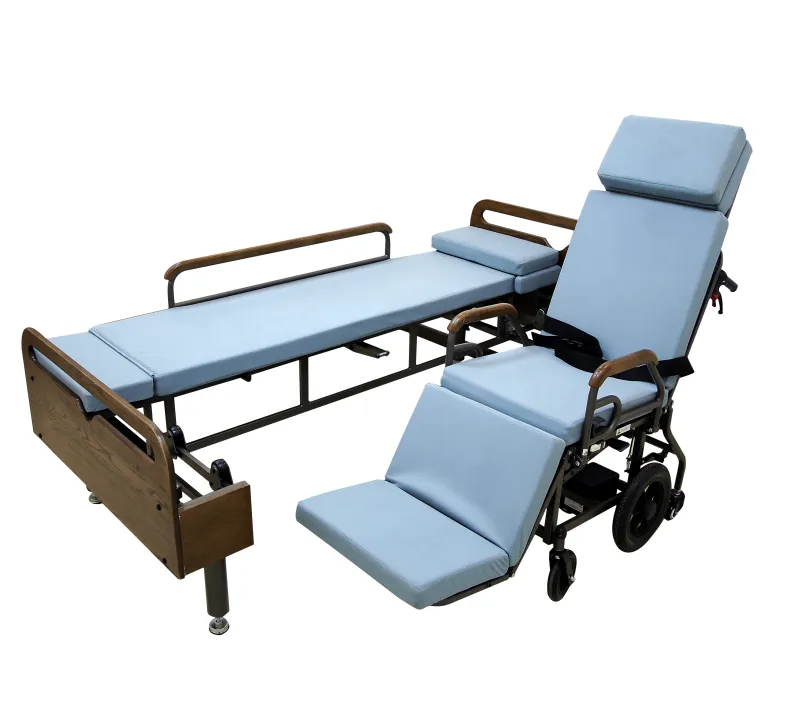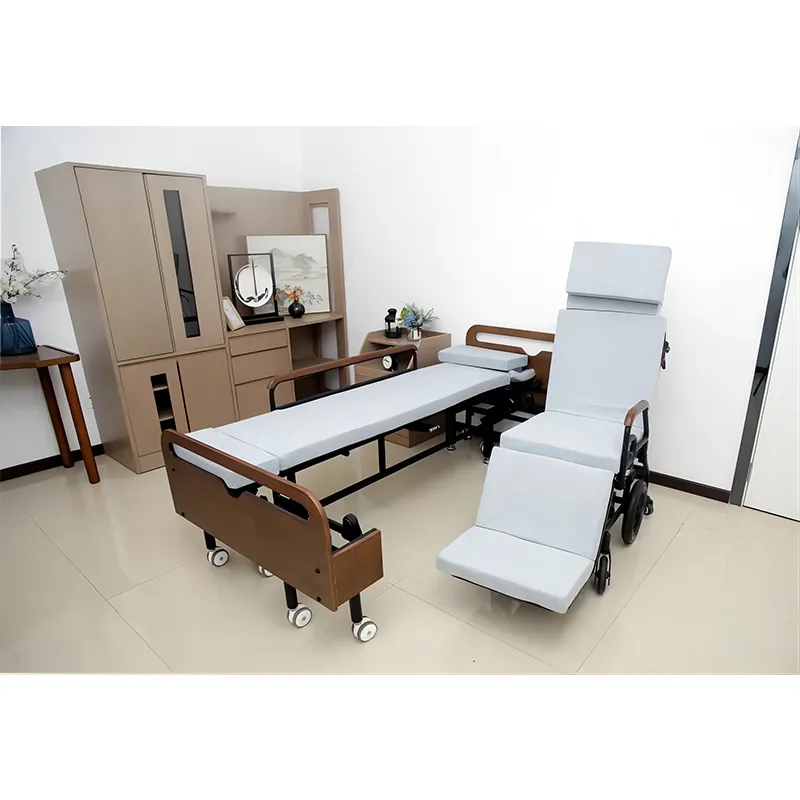
- Home
- >
- News
- >
- What Is A High-Low Bed?
- >
What Is A High-Low Bed?
2024-09-03 15:30

As a core device in medical care, hospital beds are not only related to the comfort of patients, but also directly related to the treatment effect. Among the many functions, the design of high-low beds is particularly critical. It is not just a simple adjustment function, but also an indispensable part of medical care.
So, what exactly is a high-low bed? Why is it so important? In a hospital environment, how should the height of the bed be set? This news will take you to explore this key issue in depth.
What Is A High-Low Bed?
As the name suggests, a high-low bed is a bed with adjustable height. This type of bed is usually equipped with an electric or manual height adjustment system, so that the height of the bed can be raised and lowered as needed. This design can not only meet the needs of different patients, but also provide more convenient nursing conditions for caregivers.
In the medical environment, high-low hospital beds are widely used, especially in inpatient wards, operating rooms, and rehabilitation centers. Its adjustment function allows patients to obtain the most suitable treatment posture in different situations, and also provides better conditions for caregivers when performing nursing operations.
The Main Features of High-Low Bed Include:
● Height adjustment function: The height of the bed can be adjusted at any time according to the needs of the patient or the need for care.
● Multifunctional design: In addition to height adjustment, high-low bed is usually equipped with angle adjustment, tilt adjustment and other functions, which further improves the applicability of the bed.
● Safety: In terms of design, high-low bed usually takes into account the safety of patients, such as anti-slip devices, locking devices, etc., to ensure that there will be no accidents during the adjustment process.

Why is the High-Low Function so Important for Hospital Beds?
First of all, the high-low function allows patients to achieve the best posture and comfort in different situations. For example, when the patient needs to be examined, treated or fed, the bed can be adjusted to a higher position; when the patient needs to rest or sleep, the bed can be adjusted to a lower position, thereby reducing the pressure on the body and avoiding complications such as pressure sores.
For nursing staff, the high-low function also greatly improves work efficiency. In nursing operations, nursing staff often need to adjust the patient's posture or perform treatment operations. By adjusting the height of the bed, nursing staff can be in the most suitable working posture and reduce fatigue and strain caused by improper posture. In addition, the high-low function can also facilitate nursing staff to change bed sheets and clean the body for patients, thereby improving the overall efficiency of nursing.
Finally, safety is the top priority in hospital bed design. The design of the high-low function can effectively reduce the risk of patients falling from the bed. For example, when patients need to get in and out of bed, the bed can be adjusted to a lower position to reduce the height of the fall and the risk of injury. At the same time, high-low beds are usually equipped with locking devices to prevent patients from accidentally moving during adjustment.
Why High-Low Beds are Ideal for All Types of Patients and Caregivers?
The reason why high-low hospital beds are ideal for all types of patients and caregivers is mainly because of their excellent performance in adaptability, functionality and safety. Whether it is children, the elderly or patients with limited mobility, high-low beds can be adjusted according to their specific needs to provide the best care conditions.
The height adjustment function of high-low beds enables them to adapt to the needs of different types of patients. For example, pediatric patients usually require a lower bed, while elderly patients may need a higher bed to facilitate getting in and out of bed. The height adjustment function of high-low beds makes all this simple and flexible. High-low bed can not only adjust the height, but also usually equipped with a variety of functions, such as bed angle adjustment, mattress tilt adjustment, etc. The combined use of these functions can provide more comprehensive nursing support for different types of patients. For example, for patients who need to stay in bed for a long time, the adjustment function of high-low bed can help them change their posture regularly and reduce the discomfort and complications caused by long-term bed rest.
The design of high-low bed fully considers the safety of patients. In addition to the function of preventing falls, high-low bed is also equipped with a variety of safety devices, such as bedside guardrails, locking devices, etc. The existence of these devices not only ensures the safety of patients when they move in bed, but also greatly reduces the risks that may occur to nursing staff during the nursing process.
Is it Better for Hospital Beds to be Lower or Higher?
The height setting of hospital beds is an issue that needs to be carefully considered, because it directly affects the comfort of patients, the convenience of nursing and the safety of operation. As for whether the bed should be set lower or higher, the actual situation depends on the specific nursing needs and the patient's physical condition.
Pros of Low-Position Setting
The main pro of low-position setting is that it reduces the risk of patients falling. Especially for patients who are immobile, unconscious or at risk of falling, adjusting the bed to a lower position can effectively reduce the height of the fall, thereby reducing possible injuries.
In addition, the low setting is also conducive to patients getting in and out of bed, especially for older or frail patients. When the bed height is close to the ground, patients can get in and out of bed more easily without additional help.
Pros of High Setting
In contrast, the high setting facilitates the operation of caregivers. For example, when performing nursing operations or treatments, caregivers can adjust the bed to a higher position, thereby reducing the discomfort and physical burden caused by bending over or lifting the patient. This not only improves the efficiency of nursing, but also reduces the risk of strain caused by improper posture for caregivers.
In addition, the high setting is also suitable for some special medical operations, such as surgical preparation, examination or special treatment. In these cases, the high setting can provide better operating vision and convenience.
Therefore, the height setting of hospital beds should be adjusted according to specific circumstances. In daily care, it may be necessary to flexibly adjust the height of the bed according to the needs of the patient and the needs of the nursing operation to provide the best care effect.

How High Should the Hospital Bed be From the Ground?
There are usually certain standards for the height setting of hospital beds, which are based on a combination of factors such as patient needs, the convenience of nursing operations, and safety. Generally speaking, the height of hospital beds should be between 40 and 80 cm, and the specific height should be adjusted according to the patient's physical condition and nursing needs.
Standard Height Setting
The height of most hospital beds is set between 50 and 70 cm. This height can not only meet the needs of patients getting in and out of bed, but also provide sufficient convenience for nursing staff to operate. This height range is suitable for most patients, especially those who can get in and out of bed by themselves.
Special Height Setting
For some special patients, such as children, the elderly or patients with limited mobility, the height of the bed may need to be specially adjusted. For example, the bed height of pediatric patients is usually set between 40 and 50 cm so that they can easily get in and out of bed; while for elderly patients or patients with limited mobility, the height of the bed may be set lower to reduce the risk of falling.
At the same time, for patients who need frequent nursing operations or special treatments, the height of the bed may need to be set higher to facilitate the operation of nursing staff.
What is the Height of Different Types of Hospital Beds from the Ground?
● Standard hospital beds are usually set between 50 and 70 cm, which can meet the needs of most patients and provide sufficient convenience for nursing operations. Standard hospital beds are suitable for most general wards and are the most common type of beds in hospitals.
● The height of children's hospital beds is usually set between 40 and 50 cm so that children can get in and out of bed by themselves. Because children's bodies are more sensitive, the height of the bed is set relatively low to ensure their safety and comfort.
● The height of elderly hospital beds is usually set between 40 and 60 cm. Because the elderly are less mobile and more fragile, a lower bed setting can reduce the risk of falling and also make it easier for them to get in and out of bed.
● Intensive care hospital beds are usually equipped with a more complex adjustment system, and the height of the bed can be adjusted between 40 and 80 cm. This type of bed is usually used in intensive care units and can be adjusted in height according to the specific needs of the patient to provide the best nursing conditions.
● The height of surgical hospital beds is usually set between 60 and 80 cm. Due to the needs of surgical operations, the height of surgical hospital beds is set higher to facilitate the operation of doctors and nursing staff. In addition, the surgical hospital bed is also equipped with a variety of angle adjustment functions to meet different needs during surgery.

Conclusion
As a key design feature of hospital beds, high-low bed plays an irreplaceable role in the care and treatment of patients. Through height adjustment, high-low hospital bed can not only improve the comfort of patients, but also provide more convenient operating conditions for nursing staff. At the same time, reasonable height settings can effectively reduce the risk of patients falling and ensure their safety.
In different nursing scenarios, the functions and pros of high-low bed are fully reflected. Whether it is children, the elderly or critically ill patients, high-low hospital bed can adjust the height according to their specific needs to provide them with the best nursing conditions.
Therefore, understanding the functions and applications of high-low hospital bed is essential for selecting and using hospital beds. In daily care, flexible adjustment of the height of the bed can better meet the needs of patients and nursing staff and improve the overall effect of care.








